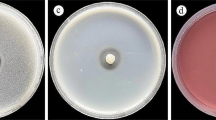Abstract
The effect of Paxillus involutus, Laccaria laccata, Suillus luteus, S. bovinus, Hebeloma crustuliniforme and a strain of the ectendomycorrhizal fungus Mrg X (Ascomycotina) on the content of phenolic compounds: ortho-diphenols and total soluble phenols in roots of Pinus sylvestris seedlings grown in vitro was investigated. Mycorrhizal fungi varied significantly in the ability to influence the concentration of phenolics in Scots pine roots. Plants inoculated with S. luteus accumulated the lowest amount of the phenolics, whereas the amount of phenolics in pine roots inoculated with L. laccata was the highest.
Similar content being viewed by others
References
Asiegbu F.O., Johansson M., Woodward S., Hütterman A. 1998. Biochemistry of the host-parasite interaction. In: Heterobasidion annosum. Biology, Ecology, Impact and Control, ed. by S. Woodward, J. Stenlid, R. Karjalainen, A. Hüttermann. University Press, Cambridge, 167–193.
Duchesne L.C., Peterson R.L., Ellis B.E. 1987. The accumulation of plant-produced antimicrobial compounds in response to ectomycorrhizal fungi: a review. Phytoprotection, 68: 17–27.
Hacskaylo E. 1983. Researching the potential of forest tree mycorrhizae. Plant and Soil, 71: 1–8.
Haars A., Chet J., Hütterman A. 1981. Effect of phenolic compounds and tannins on growth and laccase activity of Fomes annosus. Eur. J. For. Path., 11: 67–76.
Higuchi T., Shimada M. 1967. Biochemical studies on heartwood formation. IUFRO Section 41, München.
Johnson G., Schaal L.A. 1957. Accumulation of phenolic substances and ascorbic acid in potato tuber tissue upon injury and their possible role in disease and resistance. Amer. Potato J., 34: 200–209.
Karolewski P., Giertych M.J. 1994. Influence of toxic metal ions on phenols in needles and roots, and on root respiration of Scots pine seedlings. Acta Soc. Bot. Pol., 63: 29–35.
Koide R.T., Suomi L., Stevens C.M., McCormick L. 1998. Interactions between needles of Pinus resinosa and ectomycorrhizal fungi. New Phytol., 140: 539–547.
Kropp B.R., Langlois C.G. 1990. Ectomycorrhiza in reforestation. Can. J. For. Res., 20: 438–451.
Krupa S., Fries N. 1971. Studies on ectomycorrhizae of pine. I. Production of volatile organic compounds. Can. J. Bot., 49: 1425–1431.
Kuć J. 1972. Phytoalexins. Ann. Rev. Phytopath., 10, 207–232.
Malajczuk N., Molina R., Trappe J. M. 1982. Ectomycorrhiza formation in Eucalyptus. I. Pure culture synthesis, host specificity, and mycorrhizal compatibility with Pinus radiata. New Phytol., 91: 467–482.
Marx D.H. 1969. The influence of ectotrophic mycorrhizal fungi on the resistance of pine roots to pathogenic infections. I. Antagonism of mycorrhizal fungi to root pathogenic fungi and soil bacteria. Phytopathol., 59: 153–163.
Marx D.H. 1972. Ectomycorrhizae as biological deterrens to pathogenic root infections. Ann. Rev. Phytopathol., 10: 429–454.
Melin E. 1963. Some effects of forest tree roots on mycorrhizal basidiomycetes. In: Symbiotic associations, ed. by P. S. Nutman and B. Mosse. Cambridge University Press, pp. 125–145.
Molina R. 1981. Ectomycorrhizal specificity in the genus Alnus. Can. J. Bot., 59:325–334.
Molina R., Trappe J. M. 1982. Patterns of ectomycorrhizal host specificity and potential among pacific northwest conifers and fungi. Forest Science, 28: 423–458.
Napierała-Filipiak A., Werner A., Mardarowicz M., Gawdzik J. 2001. Concentrations of terpenes in mycorrhizal roots of Scots pine (Pinus sylvestris L.) seedlings grown in vitro. Acta Physiol. Plant., 24: 137–143.
Nylund J.E. 1981. The formation of ectomycorrhiza in conifers: structural and physiological studies with special reference to the mycobiont Piloderma croceum Erikss. and Hjortst. Ph. D. thesis. University of Uppsala, Uppsala, Sweden, 37pp.
Pachlewski R. 1983. Grzyby symbiotyczne i mikoryza sosny (Pinus sylvestris L.). Prace IBL, 165: 1–133.
Piché Y., Fortin J.A., Lafontaine J.G. 1981. Cytoplasmic phenols and polysaccharides in ectomycorrhizal and nonmycorrhizal short roots of pine. New Phytol., 88: 695–703.
Rudawska M. 1993. Mikoryza. In: Biologia sosny zwyczajnej, ed. by S. Białobok, A Boratyński, W. Bugała. Sorus, Poznań-Kórnik, pp. 137–182.
Shain L. 1979. Dynamic responses of differentiated sapwood to injury and infection. Phytopathol., 69: 1143–1147.
Souto X.C., Chiapusio G., Pellissier F. 2000. Relationships between phenolics and soil microorganisms in spruce forests: Significance for natural regeneration. J. Chemic. Ecol. 26: 2025–2034.
Stenlid J., Johansson M. 1987. Infection of roots of Norway spruce (Picea abies) by Heterobasidion annosum. II Early changes in phenolic content and toxicity. Eur. J. For. Path., 17: 217–226.
Swain T., Hillis W.K. 1959. The phenolic constituents of Prunus domestica. The quantitative analysis of phenolic constituents. J. Sci. Food and Agric. 1: 63–68.
Werner A. 1990. Tissue responses of thin roots of Scots pine to infection by Heterobasidion annosum. Bulletins of the Finnish Forest Research Institute, 360: 161–169.
Werner A. 1991. Odporność sosny zwyczajnej na hubę korzeni i przebieg choroby siewek sosny. PWR i L Poznań, pp. 1–168.
Werner A., Idzikowska K. 2001. Host/pathogen interaction between Scots pine seedlings (Pinus sylvestris L.) and the P strains of Heterobasidion annosum (Fr.) Bref. in pure culture. Acta Soc. Bot. Pol., 70: 119–132.
Zak B. 1964. Role of mycorrhizae in root disease. Ann. Rev. Phytopathol., 2: 377–392.
Author information
Authors and Affiliations
Rights and permissions
About this article
Cite this article
Napierała-Filipiak, A., Werner, A. & Karolewski, P. Content of phenolics in mycorrhizal roots of Pinus sylvestris seedlings grown in vitro . Acta Physiol Plant 24, 243–247 (2002). https://doi.org/10.1007/s11738-002-0047-z
Received:
Accepted:
Issue Date:
DOI: https://doi.org/10.1007/s11738-002-0047-z




